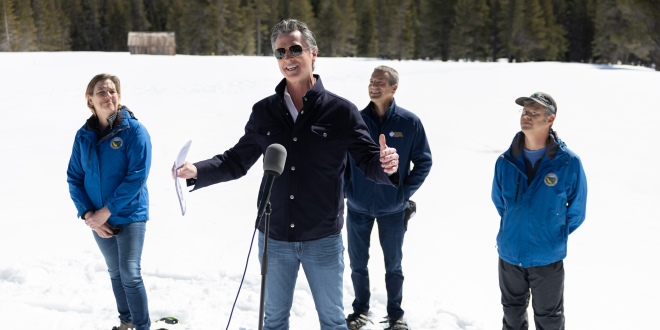Earlier this week, Governor Gavin Newsom unveiled his updated water plan for California while participating in the April snow survey at Phillips Station which showed an above average snowpack for the state. He spoke about the need to protect California’s water supplies from the climate crisis while boosting our ability to capture and store water for when dry conditions return.
“In the past few years alone, we’ve gone from extreme drought to some of the most intense rain and snow seasons on record – showcasing the need for us to constantly adapt to how we manage our water supplies. The water plans and strategies we’re implementing are each targeted components of our overall effort to deliver clean water to Californians by capturing, storing, and conserving more water throughout the state. This plan is a critical component of that effort.”
In the updated plan, Newsom focuses on investing billions of dollars on major infrastructure projects such as the Delta Conveyance and the Sites Reservoir, which would become the largest new reservoir built in California in the past 50 years, while also strengthening watersheds, and closing a gap in “long-standing inequities” in water management.
Specifically, the California Water Plan Update 2023 identifies seven objectives:
- Support watershed resilience planning and implementation – The State will prioritize actions, programs, and funding so local communities can improve and accelerate climate resilience planning and implementation in their watersheds.
- Improve resiliency of “backbone” State, federal, and regional built water infrastructure – As built infrastructure ages, it must become more resilient to adapt its operations for climate change, be better integrated with other systems, and improve information sharing.
- Improve resiliency of natural “backbone” infrastructure – Built infrastructure relies on natural infrastructure, such as rivers, lakes, groundwater basins, and more. Improving resilience means faster ecosystem restoration and identifying key ecosystems and groundwater basins.
- Advance equitable outcomes in water management – Resilience for California means resilience for all. However, inequities exist in California’s institutional systems. Recommendations include improving community outreach, engagement, and access to State assistance programs.
- Support and learn from Tribal water and resource management practices – California Native American Tribes have a history of sustainability managing water and other resources. We must support and learn from Tribal water management practices and help Tribal communities address ongoing challenges like access to funding, engagement, and water rights issues.
- Support and increase flexibility of regulatory systems – Regulatory programs that are flexible and adaptable to meet the challenges of changing hydrology must be supported.
- Provide guidance and support continued resources for implementation of actions toward water resilience – Sustainable resources such as funding at the local, state, federal levels are needed to develop statewide and watershed resilience. This objective’s recommendations align resources with the needs of California water management.
The Department of Water Resources is hosting a two-hour webinar on Monday, April 29, 2024 from 10:00 a.m. – 12:00 p.m. to highlight the key points of California Water Plan Update 2023. The webinar will also highlight upcoming projects and funding that put California Water Plan Update 2023 into action. To attend this webinar please register via Zoom.
 California Water News Daily Your Source For Water News in California
California Water News Daily Your Source For Water News in California


